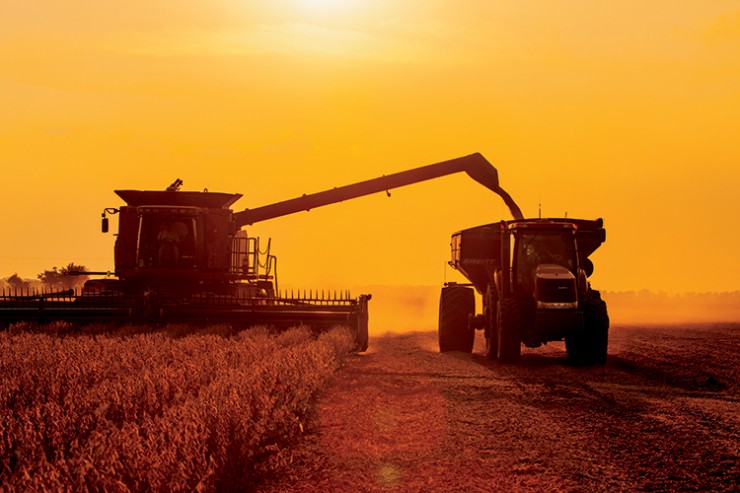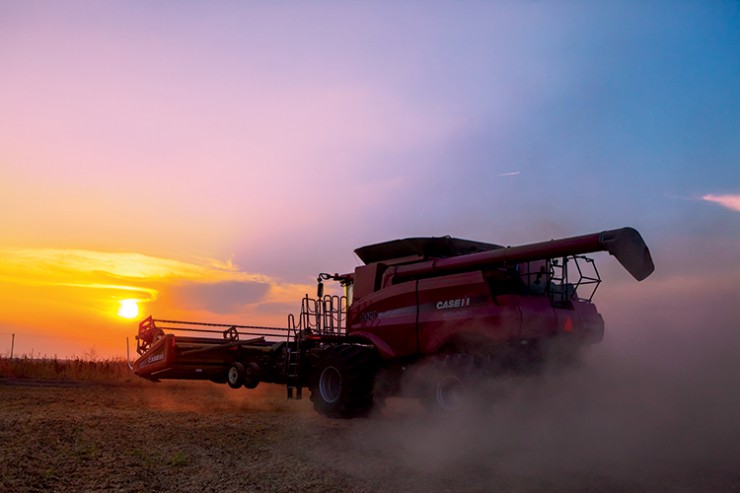Home > Mississippi > Mississippi Environment > Mississippi Smart Farms
Mississippi Smart Farms
In partnership with: Mississippi Department of Agriculture and Commerce
 From global-positioning guidance systems to smartphone applications, Mississippi’s corn and soybean farmers are on the cutting edge of technology. Farmers today can better produce the state’s top crops, thanks in part to technology, says Trent Irby, Mississippi State University (MSU) Extension soybean specialist. “Technology helps our producers cover the acres more efficiently,” he says. “GPS guidance systems contribute in ways such as more precise application of inputs, fuel and labor savings, and, if need be, equipment operation around the clock.” The technology list is lengthy. And many of these technologies help corn and soybean farmers realize benefits ranging from input savings to soil conservation methods, such as minimum- and no-tillage practices, he says. These attributes prove beneficial for the environment, as well as farmers’ bottom line.
From global-positioning guidance systems to smartphone applications, Mississippi’s corn and soybean farmers are on the cutting edge of technology. Farmers today can better produce the state’s top crops, thanks in part to technology, says Trent Irby, Mississippi State University (MSU) Extension soybean specialist. “Technology helps our producers cover the acres more efficiently,” he says. “GPS guidance systems contribute in ways such as more precise application of inputs, fuel and labor savings, and, if need be, equipment operation around the clock.” The technology list is lengthy. And many of these technologies help corn and soybean farmers realize benefits ranging from input savings to soil conservation methods, such as minimum- and no-tillage practices, he says. These attributes prove beneficial for the environment, as well as farmers’ bottom line.  Tractors equipped with GPS guidance systems can be driven hands-free through the field with greater accuracy than car navigation systems. Computer screens in machinery cabs offer real-time application data, Irby says. Advancements in biotechnology give corn and soybean plants the ability to combat pests and withstand herbicides that control weeds. Soil moisture sensors help farmers irrigate more efficiently. “Smartphones and tablets are extremely helpful in the field,” Irby says. “There are a number of ‘apps’ that our producers and consultants use frequently. These tools put information in their hands immediately.” Erick Larson, MSU Extension corn specialist, says many farmers use a form of precision agriculture-based soil sampling and fertility programs. The introduction of GPS technology pairs site-specific soil tests with the option of site-specific fertilizer application, known as variable-rate technology. Farmers once applied fertilizer on their fields uniformly. Today, they see benefits from micromanaging some fields. “It means that more of those inputs are applied only where needed in modest amounts,” says Larson. “Farmers try to do things efficiently. They want to grow a productive crop. There is no incentive for them to over apply fertilizer and pesticides. They want their land to remain productive and do it in an efficient manner.” Three generations of the Clements family grow corn and soybeans together at GT&T Farms in Greenville located in the Mississippi Delta. Tim Clements knows careful use of the farm’s resources will ensure a future for generations. He says his family has adopted irrigation technologies, and they are passionate about conserving water.
Tractors equipped with GPS guidance systems can be driven hands-free through the field with greater accuracy than car navigation systems. Computer screens in machinery cabs offer real-time application data, Irby says. Advancements in biotechnology give corn and soybean plants the ability to combat pests and withstand herbicides that control weeds. Soil moisture sensors help farmers irrigate more efficiently. “Smartphones and tablets are extremely helpful in the field,” Irby says. “There are a number of ‘apps’ that our producers and consultants use frequently. These tools put information in their hands immediately.” Erick Larson, MSU Extension corn specialist, says many farmers use a form of precision agriculture-based soil sampling and fertility programs. The introduction of GPS technology pairs site-specific soil tests with the option of site-specific fertilizer application, known as variable-rate technology. Farmers once applied fertilizer on their fields uniformly. Today, they see benefits from micromanaging some fields. “It means that more of those inputs are applied only where needed in modest amounts,” says Larson. “Farmers try to do things efficiently. They want to grow a productive crop. There is no incentive for them to over apply fertilizer and pesticides. They want their land to remain productive and do it in an efficient manner.” Three generations of the Clements family grow corn and soybeans together at GT&T Farms in Greenville located in the Mississippi Delta. Tim Clements knows careful use of the farm’s resources will ensure a future for generations. He says his family has adopted irrigation technologies, and they are passionate about conserving water.  Irrigation sensors determine soil moisture to prevent over irrigation. Timers on their wells reduce water and energy use. The farm also uses the Pipe Hole and Universal Crown Evaluation Tool (PHAUCET) program to determine their system’s hole sizes, water pressure and the timeliness of watering fields with different row lengths. PHAUCET is a free software tool from the U.S. Department of Agriculture that may conserve water pumped from the Delta’s underground supply, according to MSU. “Our research has shown that PHAUCET reduces water, fuel and irrigation usage by 20 percent versus conventional irrigation sets in regular-shaped fields. In irregular-shaped fields, PHAUCET could reduce water use as much as 50 percent,” says Tom Eubank, agronomic crops specialist with MSU’s Extension Service. In the end, the message correlates among all these farm technologies, which intend to improve profits and production with minimal environmental impact. “We live in the Mississippi Delta and the majority of our water comes from the Mississippi River alluvial aquifer. And we don’t want to end up like other areas of the country that are having supply problems from the aquifer,” Clements says. “We want to use it at a rate that it can recharge itself and be sustainable. We want it to be available for future generations.”
Irrigation sensors determine soil moisture to prevent over irrigation. Timers on their wells reduce water and energy use. The farm also uses the Pipe Hole and Universal Crown Evaluation Tool (PHAUCET) program to determine their system’s hole sizes, water pressure and the timeliness of watering fields with different row lengths. PHAUCET is a free software tool from the U.S. Department of Agriculture that may conserve water pumped from the Delta’s underground supply, according to MSU. “Our research has shown that PHAUCET reduces water, fuel and irrigation usage by 20 percent versus conventional irrigation sets in regular-shaped fields. In irregular-shaped fields, PHAUCET could reduce water use as much as 50 percent,” says Tom Eubank, agronomic crops specialist with MSU’s Extension Service. In the end, the message correlates among all these farm technologies, which intend to improve profits and production with minimal environmental impact. “We live in the Mississippi Delta and the majority of our water comes from the Mississippi River alluvial aquifer. And we don’t want to end up like other areas of the country that are having supply problems from the aquifer,” Clements says. “We want to use it at a rate that it can recharge itself and be sustainable. We want it to be available for future generations.”



